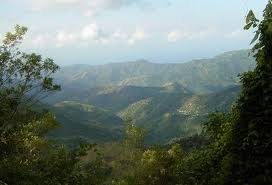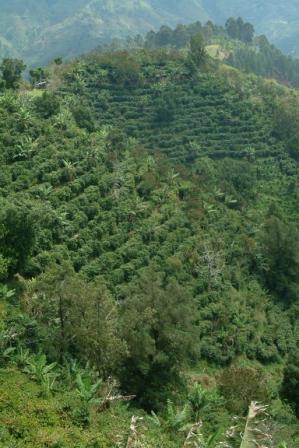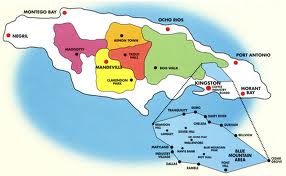Jamaica Blue Mountain Coffee History
Jamaica Blue Mountain Coffee
A Short History
Chapter One – Coffee Arrives in the Caribbean

The story of Blue Mountain Coffee begins in the early 18th century. Coffee once it arrived, flourished in Jamaica, especially in the cool, misty climate of the Blue Mountains that rise up behind Kingston. Though production is much reduced from the 20 million pounds of coffee produced in Jamaica in the early 19th century, it remains the finest coffee in the world. The story of how coffee arrived in Jamaica is somewhat mundane, so we start our story a little earlier, with the arrival of coffee to the Caribbean.
In 1728 by some accounts, or 1730 in others, Nicholas Lawes, a former governor of Jamaica, brought the first coffee plants to Kingston and planted them in St. Andrews Parish. Famous for trying pirates, including “Calico Jack” Rackham, Mary Reade and Anne Bonny, he apparently had decided to settle into civilian life pioneering coffee cultivation at his Temple Hill estate. Little more about Governor Lawes can be found regarding his cultivation of coffee, but the story of the progenitor of those first few plants is known, at least mostly known. The first trees were obtained from the French at Martinique. All the coffee trees in Martinique (and eventually the rest of the Caribbean) descended from a single sapling carried over from France. And courts and cafés of France is where this story begins.
The first coffee beans appear to have been introduced to France in Marseille by French traders returning from an extended sojourn in the Levant around 1660. These traders decided they could not live without coffee and imported for their own use, and then for others. Marseille is where the first French café was founded. Eventually the drink found its way to Paris in 1669, via the Ottoman ambassador, who held opulent parties featuring the drink. But it was an Armenian, Pascal who was successful in marketing the dark, invigorating liquid, first at the fair in St. Germain, and then in a small cafe. The earliest “upper class” cafe was Procope’s, opened in 1686. Coffee, already fashionable in London and Amsterdam, was finally coming into its own in Paris in oriental style cafés.
It is doubtless that Louis XIV’s desire to obtain a coffee tree was driven by his wish to avoid having to deal through Arab traders and pay the ensuing markup. The Arab traders controlling the trade made attractive margins supplying coffee to Europe. The Dutch, driven by the same desire, were the first to successfully import and propagate a live plant in Europe, though there is almost no place in Europe where the plant would thrive except for in its greenhouses. It took several tries for the king of France to obtain a plant that would survive, as he finally did from the municipality of Amsterdam in 1714. The single 5-foot tree given Louis XIV was planted at the Jardin de Plantes, after a ceremonial reception. The Jardin des Plantes was overseen by the King’s Physician. It contained both exotic “collectible” plants from around the world as well a medicinal herb garden. And with this plant starts the lineage of almost all coffee plants found in the Carribean, Mexico, Central America, and South America.
Now, five or six years later, having provided the provenance for the “mother” coffee tree, we introduce the hero, Mathieu de Clieu. De Clieu, then stationed as captain of the infantry on Martinique, was called back to France on personal business, sometime prior to 1720. He took it upon himself to bring coffee back on the return voyage. His motivation was apparently two-fold. One was that the King was very interested in propagating coffee in the colonies. Earlier Frenchman had been unsuccessful in transporting plants to the new world (though some accounts show coffee arriving in St. Domingue as early as 1715). In addition, if he could successfully coax a coffee plantation out of the rich soil of Martinique it would likely make him a very wealthy man.
Once in Paris, the challenge was to obtain some specimens to return with. The sole plant provided by Amsterdam was being propagated by the royal physician M. de Chirac and his team of botanists at the Jardin des Plantes. Saplings were rare, and to obtain the charge to escort one back to Martinique would take some political cunning. But our Captain de Clieu was not only persistent but resourceful. He was finally successful by enlisting the charms of a “woman of quality” whose request to M. de Chirac was impossible to refuse. His ploy was successful in obtaining at least three plants which he had kept, while finishing his business in France, at Rochefort by M. Begon, who oversaw the Jardin des Plantes in that city.
De Clieu embarked at Nantes in 1723 with as many as three plants, though only one appears to have survived the journey. Just prior to the journey the government sent final instructions on the care and importance of the plants. It was hoped it could be spread throughout the French colonies, further enriching France. De Clieu understood this well and considered his charge an honor to guard and care for.
The ship sailed with a complement of some thirty crewmembers and several passengers, who like de Clieu, were travelling to the Antilles either to return home or to seek their fortune. Among these passengers was a sworn enemy of de Clieu whose animosity was apparently further stoked by De Clieu’s pride in his mission to create a French controlled source of coffee. Documents are curiously quiet regarding the man’s name, and nor do de Clieu’s letters name him. But de Clieu states that the man went so far as to cause the loss of a branch of the plant while trying to steal it. As a result, not only did De Clieu spend the voyage closely guarding his charge from inclement weather, but also from the jealous co-voyager.
Carrying a tropical plant from France to the tropics required improvising a small greenhouse where he could place the plant during the day to take advantage of the sun and its warmth. De Clieu remained on deck with the plant (or possibly plants), guarding it from any type of accident that might arise.
And it turns out that his jealous countryman was not the only threat.
On a dark night, as the ship sailed near Madeira, a cannon shot woke the passengers and sailors. A three-masted chebeck, manned by Tunisian pirates, was attacking the ship. The danger was not only of being robbed and killed, but also of enslavement in Africa. But the merchant ship was not without defenses and let loose an eight cannon fusillade which tore apart the corsair’s flank. The battle raged on for two hours, but ended shortly after de Clieu sent the pirate captain’s head flying to the deck. A final cannonade from the merchant ship and the corsair and its crew retreated.
But the danger wasn’t over. Many leagues from Martinique a storm ravaged the ship. The captain was able to save it, but the ship ran up on a reef. The pumps were not enough to lighten the ship, and the crew began to toss the ship’s cargo overboard, but to no avail. Next they began tossing barrels of fresh water and the ship rose enough to be maneuvered from its underwater snare. The storm began to ease, but not the spirits of the ship’s crew and passengers, who knew that those barrels would likely be missed sooner rather than later.

Our hero, according to his own hand, shared his meager ration of water with the sole coffee plant in his care. The plant probably suffered little in the hot arid circumstances of the final part of its voyage, given that its ancestors survived in similar climates.
Once in Martinique de Clieu planted his charge on his estate and its fecundity enabled it to be the progenitor of coffee throughout the Caribbean. Its first crop came a scant 20 months after it was planted, and by 1730 the governor of Jamaica, Nicholas Lawes, brought some plants from Martinique and introduced it to his own island, some thousand miles to the northwest. The initial planting was in the foothills of St. Andrews parish, just outside Kingston, and cultivation was soon extended into the Blue Mountains.
Bibliography
All About Coffee, William Harrison Ukers. A great history of coffee.
Galerie Dieppoise, Jean-Benôit-Desiré Cochet contains a pretty riveting account of De Clieu’s voyage, which may or not be embellished to enhance the reputation of the region’s native son. But how could it not be true, having been written by an Abbé?
Chapter Two - Coffee in Jamaica



